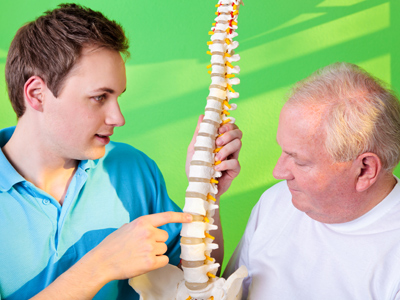
Ask the AI Tutor
Need help with Skeletons? Ask our AI Tutor!
AI Tutor - Lucy
Connecting with Tutor...
Please wait while we establish connection

The spinal column contains many smaller bones called vertebrae.
Skeletons
Skeletons give shape and support to our bodies. In KS2 Science, pupils discover how bones and joints work together to protect organs and allow movement.
1 .
What does the spinal column contain?
Bones called invertebrates
One long, flexible bone
Two bones - a neck bone and a back bone
Many smaller bones called vertebrae
Vertebrae is a plural. One of them is called a vertebra
2 .
Which device allows us to see bones inside a living animal?
A digital scanner
An X-ray or MRI machine
A photocopier
A microscope
If a doctor thinks you may have a broken bone you might have to have an X-ray
3 .
Which organ does the cranium protect?
The liver
The heart
The brain
The lungs
The cranium is another name for the skull
4 .
What is an exoskeleton?
A weak skeleton
An external skeleton
A skeleton without joints
An internal skeleton
Humans and other mammals have an endoskeleton - an internal skeleton. An exoskeleton is the opposite - an external skeleton. Animals such as spiders, insects, crabs and lobsters have exoskeletons
5 .
What is the function of the skeleton?
To protect vital organs
To allow movement
To support the body
All of the above
The skeleton protects vital organs, supports the body and allows it to move
6 .
What is an invertebrate?
An animal whose skeleton is made of cartilage
An animal without a spine
An animal with a backbone
An animal without a skeleton
An invertebrate is an animal without a spine while a vertebrate has a spine
7 .
Skeletons aid movement in animals, but they can't move on their own. What else is needed?
Joints and muscles
Muscles and tendons
Tendons and cartilage
Cartilage and joints
Joints allow the skeleton to bend while muscles provide the power to move
8 .
Which of the following statements is not true?
Bones are living tissue
Exercise helps bones to become stronger
Good nutrition helps bones to become strong
Bones do not grow
Your skeleton grows just as the rest of your body does - can you imagine what would happen if a baby's bones never grew?
9 .
Which part of the human skeleton protects the heart?
The cranium
The scapula
The sternum
The clavicle
Another name for the sternum is the breastbone
10 .
What is another name for the clavicle?
Collarbone
Skull
Shoulder blade
Shin
The shoulder blade is also known as the scapula
**Unlimited Quizzes Await You! 🚀**
Hey there, quiz champ! 🌟 You've already tackled today's free questions.
Ready for more?
Ready for more?
🔓 Unlock UNLIMITED Quizzes and challenge yourself every day. But that's
not all...
not all...
🔥 As a Subscriber you can join our thrilling "Daily Streak" against other
quizzers. Try to win a coveted spot on our Hall of Fame Page.
quizzers. Try to win a coveted spot on our Hall of Fame Page.
Don't miss out! Join us now and keep the fun rolling. 🎉
**Unlimited Quizzes Await You! 🚀**
Hey there, quiz champ! 🌟 You've already tackled today's free questions. Ready for more?
🔓 Unlock UNLIMITED Quizzes and challenge yourself every day. But that's not all...
🔥 As a Subscriber you can join our thrilling "Daily Streak" against other quizzers. Try to win a coveted spot on our Hall of Fame Page.
Don't miss out! Join us now and keep the fun rolling. 🎉






